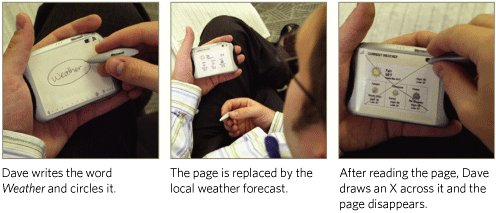Storyboards
| Once a scenario and sketches have been created to show what a product or service could be like, designers can create a storyboard (Figure 5.10) to help illustrate the product or service in use. Figure 5.10. Storyboards illustrate in words and images what the experience of a product or service will be like.
courtesy of Jennifer Anderson, Chun-Yi Chen, Phi-Hong Ha, and Dan Saffer Storyboarding is a technique drawn from filmmaking and advertising. Combining a narrative with accompanying images, designers can powerfully tell a story about a product or service, displaying its features in a context. The images on a storyboard can be illustrations or staged photos created expressly for the storyboard (I don't recommend using generic or stock images, as they will come off as stilted and likely won't be specific enough to match the scenario). Storyboards consist of these image panels, with accompanying text that can be drawn directly from the scenarios. Storyboards can also be used in conjunction with a wireframe (discussed later in this chapter) to illustrate the details of a complicated process or function. Using a storyboard, a designer can show key moments of an action. For example, a complicated drag-and-drop procedure could be shown with panels illustrating the first moment that the user picks up an object, what happens during dragging, and what happens when the object is dropped. |
EAN: 2147483647
Pages: 110
- ERP System Acquisition: A Process Model and Results From an Austrian Survey
- Enterprise Application Integration: New Solutions for a Solved Problem or a Challenging Research Field?
- Intrinsic and Contextual Data Quality: The Effect of Media and Personal Involvement
- A Hybrid Clustering Technique to Improve Patient Data Quality
- Development of Interactive Web Sites to Enhance Police/Community Relations
